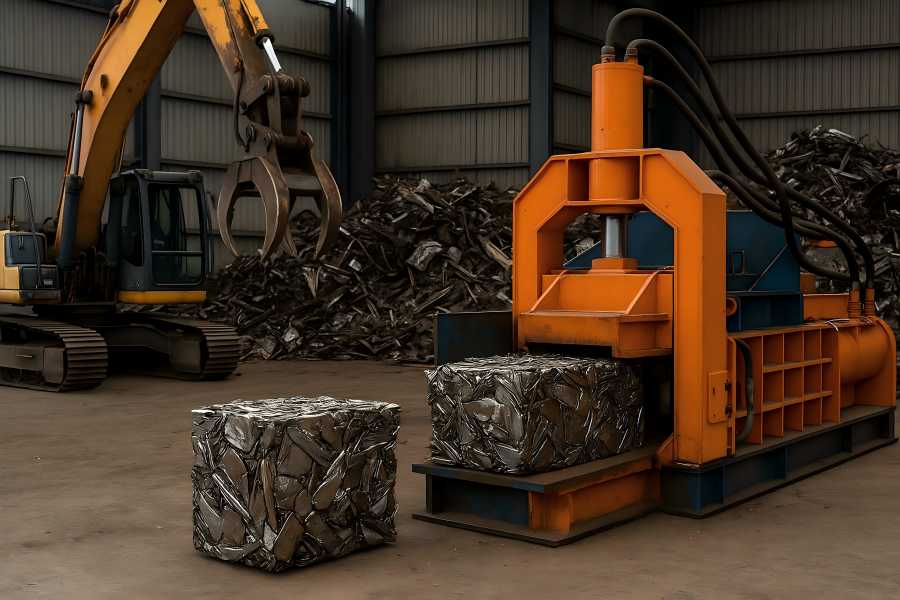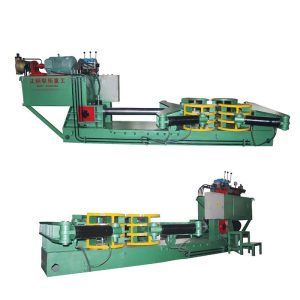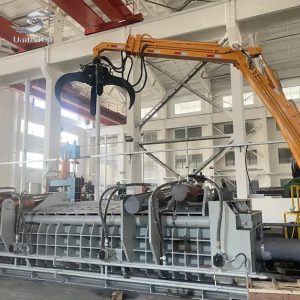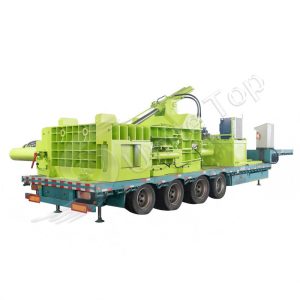Selecting the right scrap metal baler is a crucial decision for recyclers, metal processors, and manufacturers dealing with metal waste. The baler you choose directly impacts throughput, bale quality, energy efficiency, and profitability. Choosing the wrong size or capacity can lead to underperformance, higher maintenance costs, or operational bottlenecks.
This guide explains how to correctly size a scrap metal baler based on feedstock characteristics, target bale density, and power requirements—three interrelated factors that define the machine’s performance envelope.
Understanding the Purpose of a Scrap Metal Baler
A scrap metal baler compresses loose or bulky metal scrap into compact, uniform bales for easier handling, storage, and transportation. The primary objectives are to increase material density, reduce logistics costs, and standardize output for downstream smelters or recyclers.
However, different facilities process different types of feedstock—ranging from light aluminum cans to heavy industrial scrap—and each requires a baler with specific compression force, chamber volume, and hydraulic power.
The performance of a baler is best understood not by its physical size alone, but by the relationship between its feedstock handling capacity, compaction pressure, and installed power. These parameters define how efficiently the machine converts variable input materials into consistent, high-quality bales.
Step 1: Defining the Feedstock Type and Volume
The first step in sizing a scrap metal baler is identifying the nature and volume of the feedstock. Different metals exhibit vastly different flow, rebound, and compaction characteristics.
- Light Scrap: Includes aluminum cans, sheet metal, and steel turnings. These materials require less compaction pressure but higher chamber volumes to process efficiently.
- Medium Scrap: Includes automobile body panels, structural profiles, or mixed consumer scrap. These need moderate compression force and adaptable feed openings.
- Heavy Scrap: Consists of thick steel plates, rebar, and industrial offcuts. Such materials demand high-pressure systems, thicker chamber walls, and stronger structural frames.
The average daily or hourly throughput of your operation determines how many cycles per hour the baler must complete. For instance, a scrapyard processing 10 tons per hour of light-gauge material will require a baler with a larger hopper and faster cycle times than a facility compacting 3 tons per hour of heavy plate steel.
Calculating your feedstock rate (tons/hour) and loading method (manual, conveyor, or grapple) helps determine not only the chamber size but also whether you need a horizontal, vertical, or two-ram configuration.
Step 2: Choosing the Right Baler Type
Once the feedstock characteristics are clear, selecting the right baler configuration is the next step. The baler type dictates both space requirements and achievable bale density.
- Vertical Balers compress material top-down and are ideal for smaller operations handling light or medium scrap. They occupy minimal floor space and have lower energy consumption but limited throughput capacity.
- Horizontal Balers apply pressure laterally, allowing continuous feeding and higher throughput. They are suited for facilities with conveyor-fed systems or automated scrap lines.
- Two-Ram Balers use one ram for compression and another for bale ejection, providing excellent density control and faster cycling. They are preferred for operations with varied materials or where uniform bale dimensions are critical.
The machine’s bale chamber dimensions and ram force rating—typically measured in tons—should align with your target bale size and material characteristics. Over-specifying the machine can lead to excessive energy use and unnecessary capital costs, while under-specifying can limit productivity.
Step 3: Understanding Material Density and Bale Specifications
Material density is the most critical factor in determining baler sizing and performance requirements. Density directly influences both the machine’s compression force and the hydraulic pressure required.
Typical Densities (Before and After Baling)
| Material Type | Loose Density (kg/m³) | Bale Density (kg/m³) |
| Aluminum Cans | 80–100 | 800–900 |
| Steel Sheet | 250–350 | 1,000–1,200 |
| Mixed Scrap | 200–300 | 1,000–1,100 |
| Heavy Steel | 400–500 | 1,200–1,400 |
| Copper/Brass | 600–800 | 1,200–1,600 |
The compression ratio—the difference between loose and compacted densities—helps determine the baler’s hydraulic system capacity. A higher target bale density requires greater ram pressure and longer dwell time during compaction.
In most cases, achieving higher bale density improves transport efficiency and resale value. However, extremely dense bales may exceed the handling limits of forklifts or cranes, and some smelters prefer slightly less compact bales for faster melting. It’s important to balance density goals with operational practicality.
Step 4: Calculating Hydraulic Pressure and Force
The baler’s hydraulic system converts mechanical power into compressive force. The total force (F) exerted by the ram can be expressed as:
F = P × A
where
- F = Compression force (in Newtons or tons)
- P = Hydraulic pressure (in Pascals or bar)
- A = Ram cylinder area (in square meters)
For example, a hydraulic system rated at 250 bar with a piston area of 0.2 m² generates:
F = 250 × 10⁵ × 0.2 = 5 × 10⁶ N = 500 kN (≈50 tons of force)
Most industrial scrap balers operate between 150 and 300 bar, depending on material hardness and bale size. Higher pressures require stronger seals, reinforced frames, and heat-dissipating hydraulic circuits to ensure reliability.
When selecting a baler, consider both peak pressure and sustained working pressure. Machines that maintain high compression for extended periods need larger cooling systems and more robust pumps. Oversized hydraulic cylinders without adequate pump power can cause slow cycle times and reduced productivity.
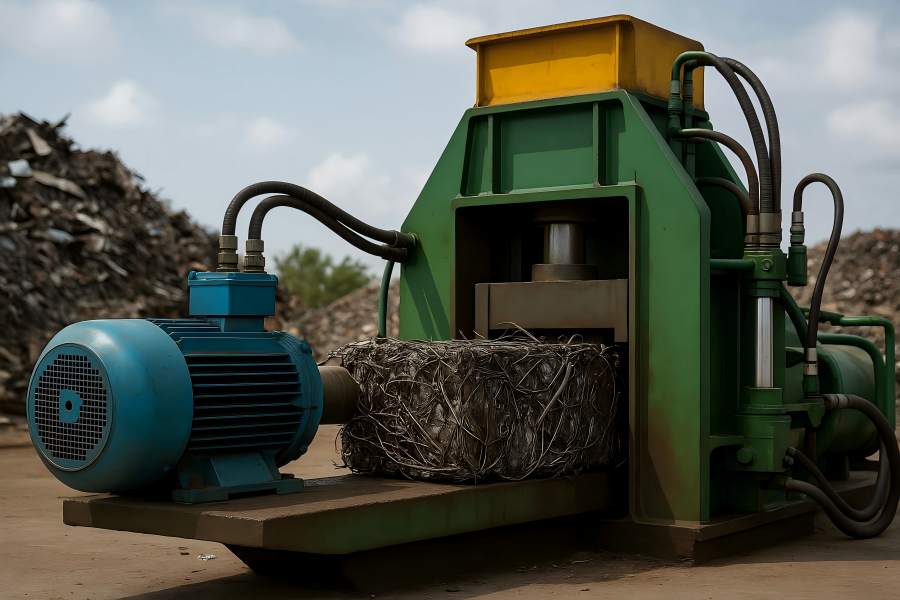
Step 5: Assessing Power Requirements
The power system—typically electric or diesel—drives the hydraulic pump that controls compression, ejection, and cycle speed. The installed power rating determines how quickly the baler completes each cycle and how efficiently it sustains pressure during compaction.
Key power-related considerations include:
- Motor Rating (kW or HP): Larger balers often require 30–100 kW motors, depending on the force and cycle rate.
- Hydraulic Pump Flow (L/min): A higher flow rate enables faster ram movement, reducing cycle time.
- Energy Efficiency: Modern balers use variable-displacement pumps and energy recovery systems to lower consumption during idle or return strokes.
- Duty Cycle: Continuous operations may demand dual-pump systems or power management modules to prevent overheating.
It’s crucial to match the motor power with both the hydraulic pump and expected duty cycle. Undersized motors cause sluggish operation and overheating, while oversized systems waste energy.
Step 6: Cycle Time and Throughput Optimization
Cycle time—the duration required to compress and eject one bale—directly affects productivity. A well-balanced system matches hydraulic power, chamber volume, and ram stroke length to minimize downtime between cycles.
Typical cycle times range from 30 seconds for light material to 90 seconds for heavy scrap. For high-volume recycling centers, reducing cycle time by even 10 seconds can significantly increase daily output.
To size correctly:
- Determine the number of bales required per hour based on throughput goals.
- Calculate the total processing time available per shift.
- Match these values with the baler’s rated cycle time and chamber volume.
Automated systems with continuous feeding and automatic tying or ejection can further boost efficiency without increasing energy demand.
Step 7: Considering Space, Loading, and Discharge Requirements
Beyond mechanical performance, spatial and operational constraints also influence baler sizing. Evaluate available floor space, ceiling height, and loading methods.
- Feed Opening: Must accommodate the largest scrap piece without pre-shredding.
- Loading Method: Manual, conveyor, or grapple-fed systems determine hopper design.
- Discharge Direction: Horizontal or vertical ejection affects layout and safety clearances.
For outdoor installations, weatherproofing and hydraulic oil heaters may be required. Facilities processing multiple scrap types should consider balers with adjustable pressure settings or pre-crush functions to handle material variability.
Step 8: Energy Efficiency and Lifecycle Costs
Energy consumption accounts for a large portion of total operating cost. Choosing a baler that achieves target densities with minimal power draw improves long-term ROI.
Modern systems employ:
- Variable-speed drives (VSD): Adjust motor speed to demand, reducing idle losses.
- Regenerative hydraulics: Reuse hydraulic energy from return strokes.
- Smart sensors: Monitor pressure and temperature for real-time optimization.
Lifecycle costs also include maintenance, hydraulic fluid replacement, and component wear. A well-sized machine operates at 70–80% of its maximum rated capacity—ensuring efficiency without strain and extending service life.
Step 9: Safety and Structural Integrity
As compression force and density increase, so does the stress on the baler’s frame and hydraulic components. Always verify that the machine meets safety and structural standards such as CE, ISO, or OSHA. Reinforced sidewalls, interlocked access doors, and overload protection systems are critical for high-pressure models.
Inadequate sizing can result in structural fatigue, seal leakage, or ram misalignment—leading to expensive downtime. Manufacturers often provide finite element analysis (FEA) simulations or stress-test data to prove the baler’s durability under expected load conditions.
Step 10: Matching Baler Capacity to Business Growth
While it’s tempting to purchase a larger baler for future expansion, oversizing can increase upfront costs and energy consumption. Instead, evaluate growth projections and select a model that allows modular upgrades, such as enhanced hydraulic pumps or larger hoppers.
For instance, some balers can be upgraded from single-ram to dual-ram systems or fitted with automation kits. Choosing a scalable model ensures adaptability without overcapitalizing initially.
Integrating Feedstock, Density, and Power into Final Selection
To bring all sizing factors together:
| Parameter | Key Question | Typical Impact on Sizing |
| Feedstock Type | Light, medium, or heavy metal? | Determines compression force and chamber size |
| Feedstock Volume | Tons/hour or day? | Affects cycle time and hopper volume |
| Target Bale Density | How dense should bales be? | Defines hydraulic pressure and ram strength |
| Power Supply | Electric or diesel? | Impacts operating cost and site setup |
| Space and Layout | Indoor/outdoor, loading method? | Influences machine orientation and footprint |
| Operational Strategy | Continuous or batch feeding? | Affects automation and discharge configuration |
Selecting the right baler involves balancing these parameters to achieve optimal performance, cost efficiency, and product consistency. Consulting with manufacturers about specific feedstock samples and density targets can further refine your sizing decision.

